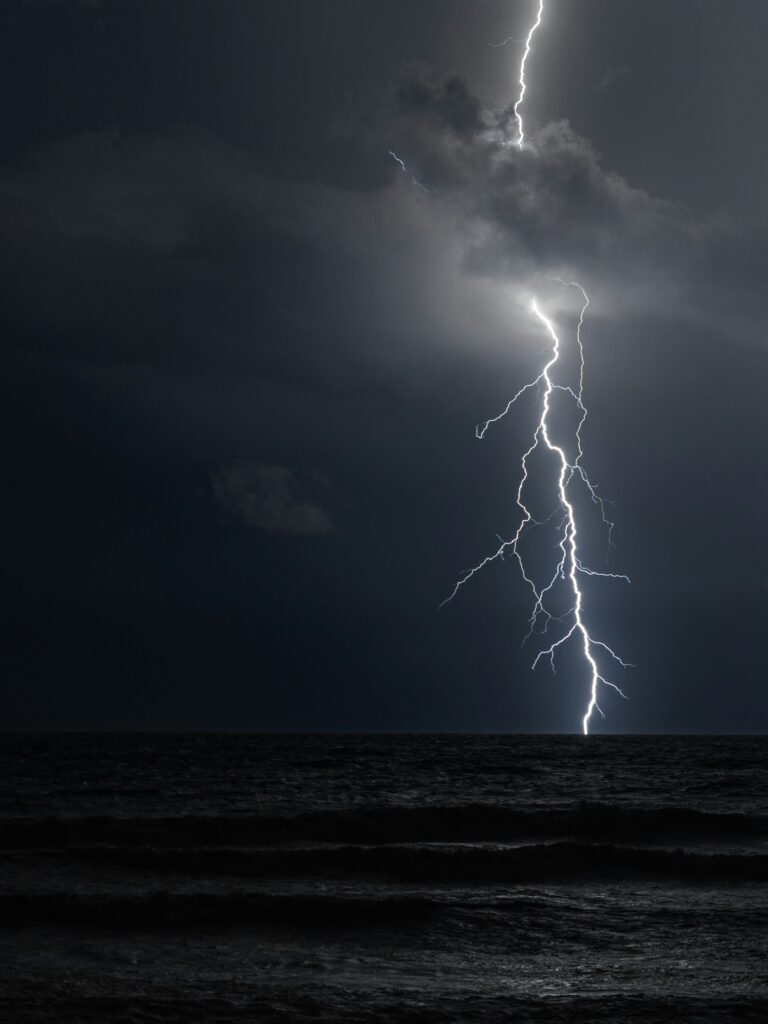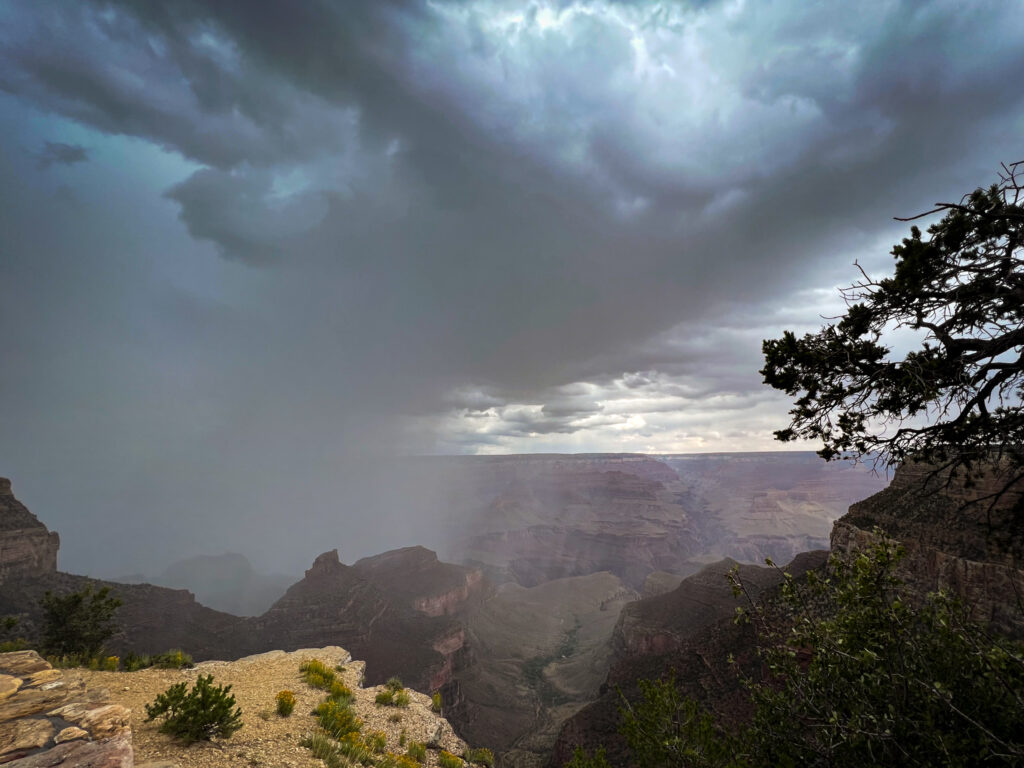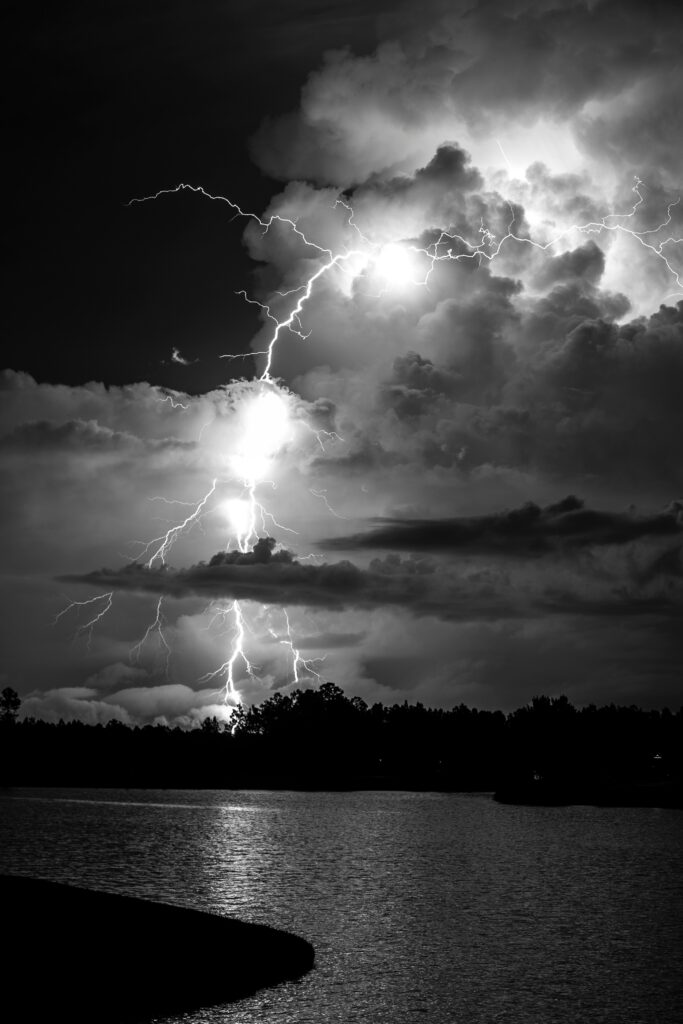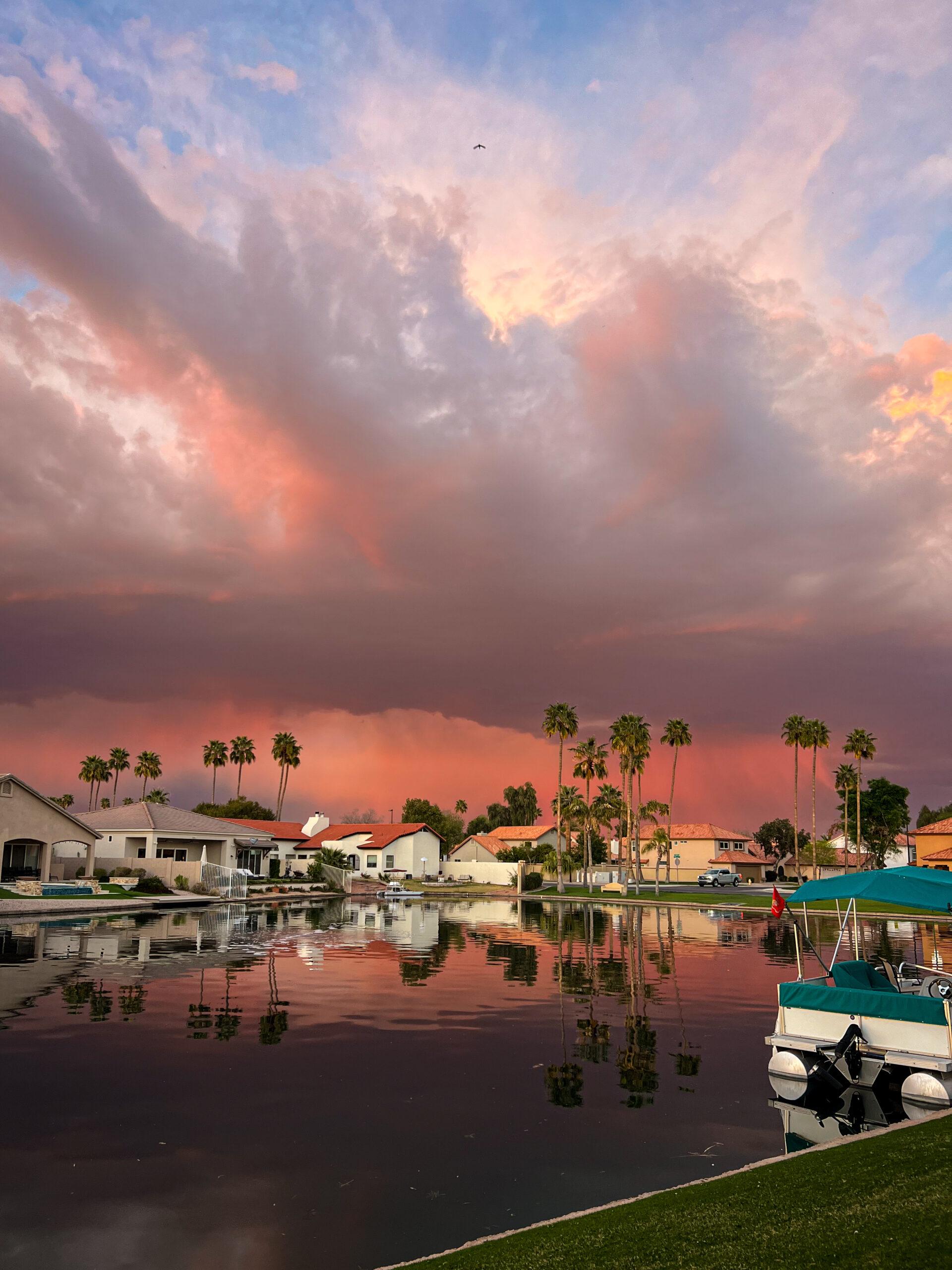My dad’s house in Gilbert sits on one of those fake lakes that you find scattered about Arizona suburbia. It’s one of many flagrant misappropriations of a rare desert resource that makes anyone, with even a modicum of environmental concern, cringe. But it’s also very pretty to look at, especially when a storm is rolling through. The reflection off of the water of the already brilliantly colored sky is often nothing short of breathtaking.
The other day I sat on the balcony overlooking the water as one last cell of a late winter storm passed by to the north, dazzling with an occasional flash of lightning and subsequent rumble of thunder. It was a very pleasant scene made only slightly less so when accompanied by the thunderous voice of the man on the other side of this imitation inlet, talking animatedly about buying a new boat “umbrella” (it’s called a bimini). But I laugh as I think of his voice in comparison with thunder; it reminds me of when I was a kid and I used to pretend I could talk to the god of thunder. Not Thor, per se; I was not well versed in Nordic myth as a child, but I had this idea in my head that there was some being in the heavens that was particularly responsible for thunder (I never bought my mom’s explanation of “angels bowling…” really?), and I used to think I could talk to him. And he sounded just like the guy pontificating across the fake lake. I don’t remember the specifics of my conversations with the thunder god, but I would be willing to bet they centered largely around striking the school so that I didn’t have to go the next day. It never worked. Perhaps that’s why I stopped trying to converse with sky deities.

Though our conversations have long since ceased, I continue to be awed by thunder and lightning. It makes me smile to think of how small we really are. I know that lightning does not come from a thunder god, nor does it spring from nothing (a big physics no-no), but from an earth-bound perspective, either of those options seem plausible. In the middle of a big storm, when the power is out throughout the neighborhood, the dog is cowering under the bed, and the wind is rustling the trees but the trees themselves aren’t visible through all of the stormy blackness; then CRACK! For a split second the world lights up like someone flung open the door to heaven itself, and then follows a KABOOM! to wake the dead, shattering the air and sending a shockwave to rattle your windows and shake your very bones.
I can’t wait for monsoon season.
Not surprisingly, the fascination with thunder is common among our species. Some of the oldest myths and legends in recorded history center around lightning and thunder. The Marvel Universe has seen to it that most of the English speaking world – as well as quite a bit of the non-English speaking bit of it – knows about Thor and his trusty hammer, Mjolnir. He is arguably the most famous of the Norse gods, defending the remainder of the pantheon, not to mention humanity, from the forces of chaos. As it turns out, Thor – as well as Zeus, Jupiter, and other heavenly big-dogs, is a by-product of the Baltic god Perkons, whose name literally means, thunderer. He wielded an axe, rather than a hammer, which he used to control thunder and lightning in order to punish pesky humans, evil spirits, and any other god audacious enough to question him. The oak tree is assumed sacred to Perkons, evidently because oaks are so often struck by lightning. Call me crazy, but I feel like that may be an indicator that he does NOT like them and is using his lightning bolts as a sort of natural weed control. But every source I’ve checked insists that they are sacred. Further proof that I will never understand the motivations of men.

Across the pond, an entirely different bevy of thunder gods and thunder legends were passed down through the generations. Native American histories are rife with stories about the creation and mechanics of lightning and thunder. One Caddo story details twin brothers, separated at birth, who receive special arrows from their father, Medicine Man. Each brother climbs a pecan tree into the heavens, causing their bones to drop back to earth (naturally). The remaining brother has to gather the bones under a buffalo hide and then shoot his arrow into the air. This brings back the first brother, bones and all, now with the power to “speak” lightning. Lightning becomes his “manhood” name and the climbing/falling bones/shooting arrow process is repeated to produce Thunder. They also manage to defeat some ogres and bring back their previously kidnapped mother, called Clay Pot Woman (I must send these names to my pregger nieces), before again ascending the very tall pecan tree to forever travel with the winds and the storms.
That’s so much better than my mom’s lame bowling angels concept.
In Japan, Raijin is the god of storms – meaning he’s in charge of the lightning and thunder as well as the rain. But not the wind. The wind is tended by his brother Fujin. The brothers appear to be inseparable and enjoy wreaking havoc and destruction around the globe. Raijin beats his drum to produce thunder while Fujin propels them about the planet with his bag of hot air (I’m not making this up), and the twins were twice credited with defending the Japanese archipelago from Mongul invasion in the late 13th century. They are a perplexing pair, however, for as often as they bring destruction, they also bring gentle, caressing breezes, winds to fill sails, and rain to nourish flora and fauna. Children must be sure to beware of Raijin, however. It is said that whether he is bringing destruction or rain, he will kidnap and gobble up children who don’t hide their belly buttons. Evidently this is because he is jealous of children born in the human world and not born, as he was, in the realm of death. I have to say I get that.
The science of thunder may not involve child-gobbling gods, magical hammers or the power to speak weather, but it is just as interesting as its mythological counterparts (well, almost). I’ve always known that thunder was the sound made by lightning, and that if you counted the lapse between the lightning strike and the thunder you could calculate the distance of the lightning from your location (5 seconds per mile). But I had never stopped to really ponder the physics of it. A lightning bolt creates a channel, and the thunder occurs when the air in that channel is heated rapidly (I feel like “rapidly” does not fully encapsulate the speed involved, but I can’t find anything better), creating enormous pressure within the channel which then expands at supersonic speeds and gives us thunder. So simple for something so magnificently powerful. But really, thunder is just a lot of hot air moving around and making a lot of noise. Not unlike a particularly loquacious local landlubber.
*Yes, I love that song and the trippy video.

Photos.
Top: Me
Left Inset: Clayton Malquist on Unsplash
Right Inset: Me again
Resources.
https://www.native-languages.org/legends-thunder.htm
xhttps://mythlok.com/8-gods-of-thunder-from-mythology/









